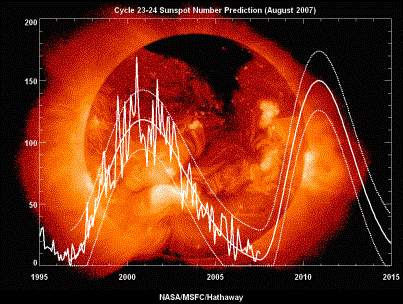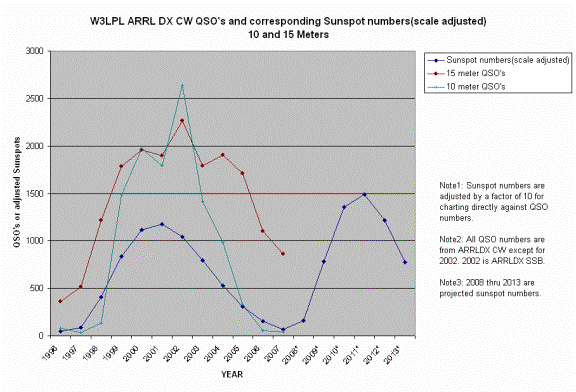Sunspots -- The Check Is In The Mail
Most folks can tell you how they came to develop an interest in amateur radio. My introduction came from several seemingly unrelated sources. One of those sources was a casual interest in astronomy and solar science. In my early teens I worked out an arrangement that allowed me access to checking out books from the library of the local small town college. That was a really big deal for a kid in a small town and I was lucky to have such a resource available. Besides the books, the library had a decent selection of non-circulating magazines. And there I discovered the sunspot/radio propagation connection.
So, back to the present. Being curious about the current lack of sunspots, I looked over at the Solar Physics site of NASA'a Marshal Space Flight center. Their most current prediction of the next sunspot cycle, cycle #24, has an interesting graphic. Their official projection is using the high end prediction of the several currently competing prediction theories. The caveat is that this prediction is based on theory which has not been proven. But it's the only game in town, right?

Sunspot Cycle Graphic -- http://solarscience.msfc.nasa.gov/images/ssn_predict_l.gif
Coincidentally, the recently published QST results for 2007 ARRL DX CW include a table showing the 10 meter QSO's decline. Their table only went back as far as the peak of the cycle. I was interested in the 10 and 15 meter trend over an entire sunspot cycle. The problem is that my own logs don't go back that far and they have too small a sample size. Also, the ARRL results published since 2000 do not include band breakdowns.
So to get a ball park idea of what might happen, I perused through some of the score summaries posted to the 3830 reflector archives at contesting.com. W3LPL has posted scores there regularly over the last decade, and I think we'd all agree that 'LPL certainly has a large enough number of QSO's logged that we can see what is going on.
I understand that this is not going to be news to most of the folks who have been operating and/or contesting for decades, but for the few who may be new to the game the following graph may be of interest. I've been told to expect propagation to improve more rapidly than it declined. But the picture really pounds that lesson home.

Also see the
chart for all bands and
the W3LPL raw QSO and adjusted sunspot data
The most interesting item from the sunspot forecast is of just how rapidly the next cycle is being predicted to ramp up. I found that of greater significance than the projection of the higher peak. If this predicted rate of increase becomes reality, we should plan to be hearing more 10 and 15 meter openings as early as the end of next year and early 2009. Generalizing further, the period from 2010-2013 is looking like the real thing. The chart also indicates that sunspot counts above 70 seem to be the sweet spot for anticipating reliable 10 meter openings. The first few years of the cycle seem to be very productive.
Now, I'll be the first to admit I'm no statistician, but the next twelve months might be a good time to get those high band antenna projects wrapped up. You'll need them to hear me on my all too low wire dipole. ;)